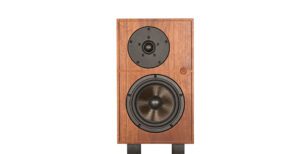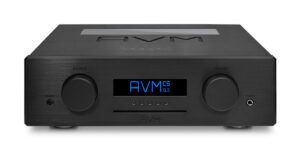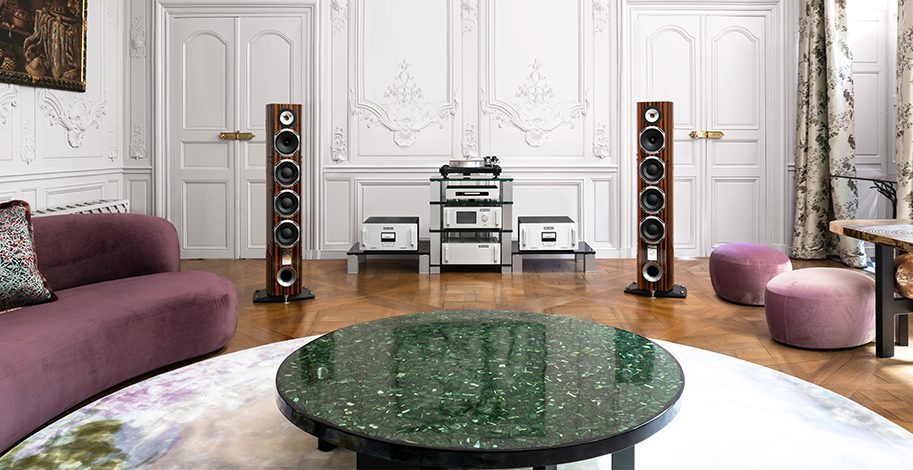
Happy 40th Birthday, Triangle. Again! French loudspeaker brand Triangle was founded in 1980, and its range-topping Magellan series was to be the perfect vehicle for that 40th anniversary. The trouble is, that was 2020 and, well… you know!
However, a party delayed is still a party, and Triangle was keen to launch the three-strong 40th Anniversary line, of which the Quatour is the largest. There were two larger Magellan models still not given the ‘40th’ treatment; the flagship Grand Concert and Concerto, but the Quatour is still a pretty substantial loudspeaker… and that sentence was an example of ‘Schrödinger’s Comma’ where both the non-existence “pretty substantial” and existence “pretty, substantial” of the comma at once change the meaning of the sentence and are both relevant.
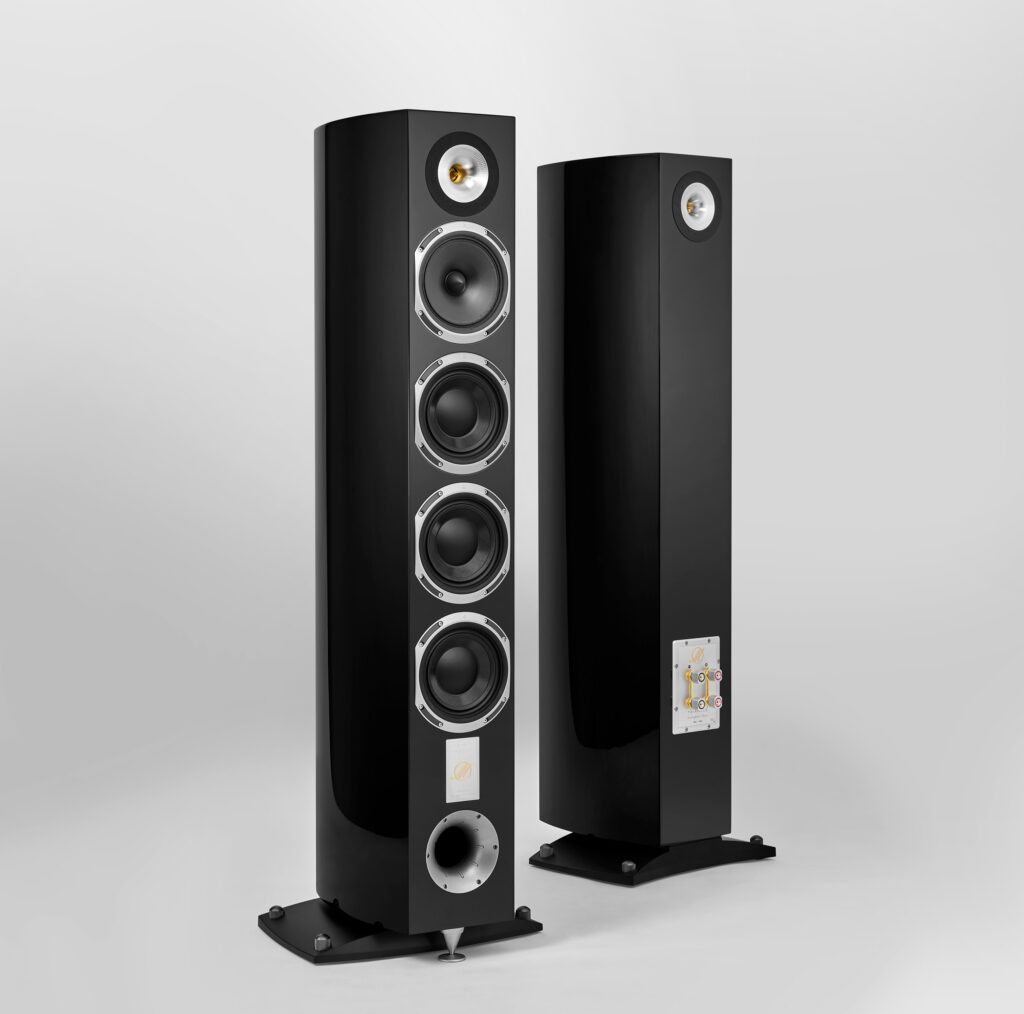
Let’s not fluff the issue here, the fit and finish of the Triangle Magellan Quatour 40th Anniversary is fantastic. There is a substantial piece of engineering behind that ‘Shadow Zebrano’ piano finish, the contrasting chrome driver surrounds, and that winged plinth with an independent front spike, but the looks get people first. It’s just the right mix of the conventional and the luxurious that really works, giving the loudspeakers a timeless appeal. So, perhaps it’s good that a 40th Anniversary model isn’t a short-lived concept, but the latest version of the Magellan Series.
Audio explorer
The Magellan line has long been Triangle’s premier range. Named after the famous Portuguese explorer, the range put Triangle on the map for many high-enders, who had hitherto discounted the brand. The range, from the two-way Duetto 40th Anniversary, through the Cello 40th Anniversary and the present range-topping Quatour 40th Anniversary and even up to the still bigger Concerto and vast Grand Concert have much in common. They all use Triangle’s own drive units and all have that beautifully finished, distinct lute-shaped cabinet.
The 135cm tall Quatour 40th Anniversary cabinet is made up of successive layers of high-density fibreboard, each 3mm thick. The combination of sophisticated cross bracing and chambering of the tweeter and tweeter/midrange units helps to reduce cabinet-induced distortion thanks to extensive studies of the micro-deformations of the cabinet itself on Triangle’s behalf.
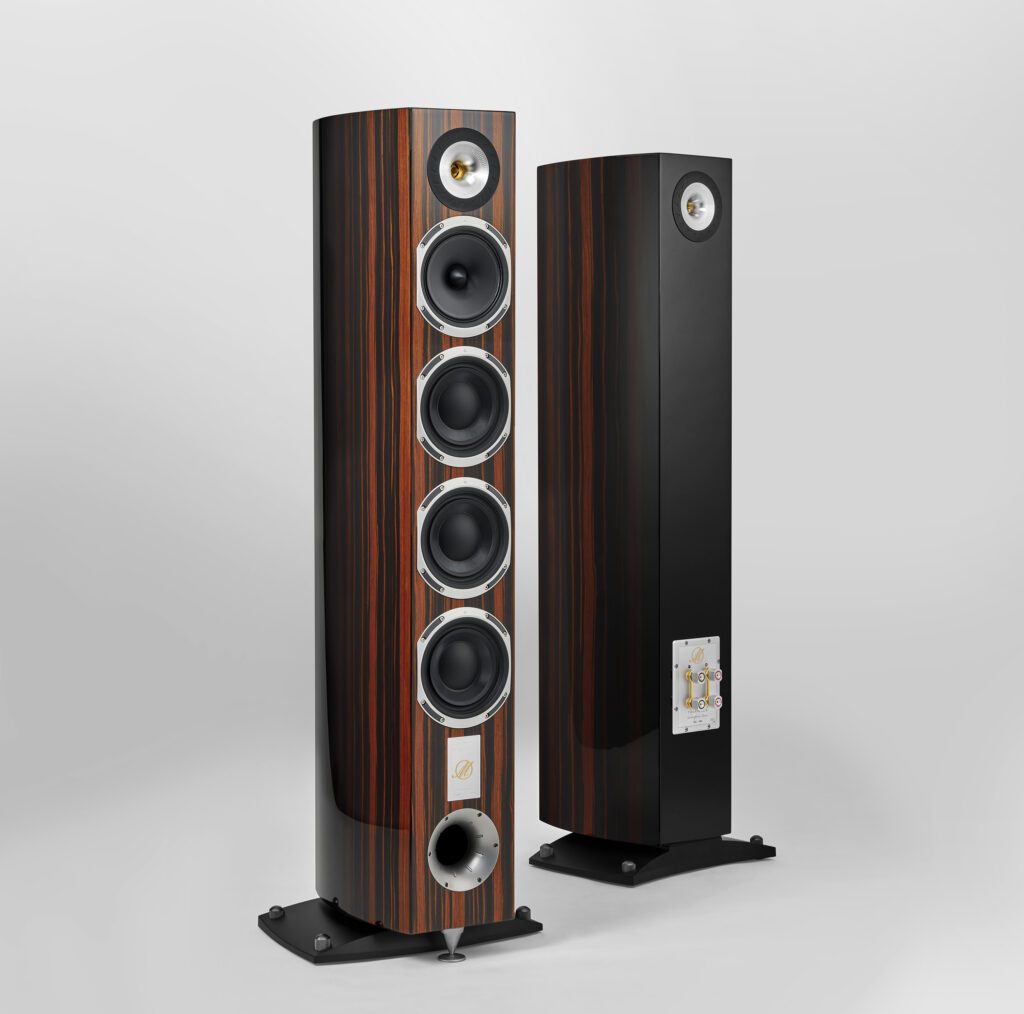
Poking out of that cabinet shows what helps take Triangle’s research and development to its current acme. The three-way, six unit loudspeaker uses a trio of 160mm bass units with the company’s proprietary SVA diaphragm and cooling system. This is met with a similarly sized 160mm midrange unit that features a paper diaphragm and pleated surround, and further up the frequency register by two magnesium alloy horn tweeters; one firing to the front as usual, and a second used in what Triangle calls ‘Dynamic Pulse System 2’; a refinement of the bipole layout of the previous Quatour model. The additional rear-firing tweeter is wired in phase with the main tweeter, which creates a ‘null’ in the space between the drive units and adds ambience without the diffuse sound of dipole designs (this diffuse effect has its uses in some older surround sound systems).
Middle management
However, with Triangle loudspeakers, the midrange is the most vital component in the frequency range. Essentially, the T16GMF100-V2 driver (made by Triangle itself) is always the most important driver in a Triangle loudspeaker and the Quatour 40th Anniversary is no exception. The company moved from doped paper to a natural cellulose pulp in the latest model; that’s basically untreated paper!
Suppose you think of the front and rear tweeters placing the loudspeaker in a medium to large room and the three bass drivers in series bringing the bass. In that case, you can think of the Triangle as a midrange unit placed in a loudspeaker cabinet that makes it work in rooms of 30 square metres and larger. The Quatour 40th Anniversary can work in smaller settings, but the amount of bass that array of 16cm woofers can deliver can overawe a smaller room. However, if you like that Triangle sound but want it in a smaller listening space, the Cello 40th Anniversary floorstander and Duetto 40th Anniversary stand-mount fit the bill.
The great thing about Triangle loudspeakers is that they are an easy load for an amplifier and the Quatour 40th Anniversary is no exception. With a claimed 91dB sensitivity and an impedance plot that never dips below three ohms, this is not a loudspeaker that needs a power station to drive it. This makes the choice of partners one of quality not quantity, and while I doubt anyone is going to partner a pair of £14,000 loudspeakers with a 35-year-old NAD 3020, the Magellan Quatour 40th Anniversary would be able to extract the best from it without destorying the amp in the process. Realistically, the Quatour becomes the perfect partner for the likes of the Audio Research I/50 (tested in this issue) and all those wonderful Luxman and Accuphase amps and small, deft-touch amps like Lavardin.
It is difficult to determine whether the loudspeakers need running in or how that run-in period changes the performance of the loudspeakers because they arrived as demonstration models with a good number of miles on the clock. However, from experience, Triangle loudspeakers need a few hours of bedding in, but sound good from the get-go.
Vive la différence
Triangle loudspeakers are unlike most designs in sound quality terms. As discussed previously, they stand or fall by their midrange. In particular, the speed of that midrange. It’s a sign of just how able Triangle’s design team is that the rest of the loudspeaker can keep up with that midrange driver sound. And, in a very real way, the Magellan Quatour 40th Anniversary is the ultimate expression of that Triangle sound.
That midrange-first sound is one of incredibly lithe and natural vocal projection. It’s no shrinking violet – the sound is forward and expressive and detailed in a way that is the exact opposite of that classic BBC sound that is laid-back, almost rounded by comparison. I played ‘Help Me’ from Joni Mitchell’s Court and Spark album [Asylum]; her voice was precise and in the room. This precision is very much at odds with her own vocal style, but it manifests as being able to make more sense of her little vocal trills and runs.
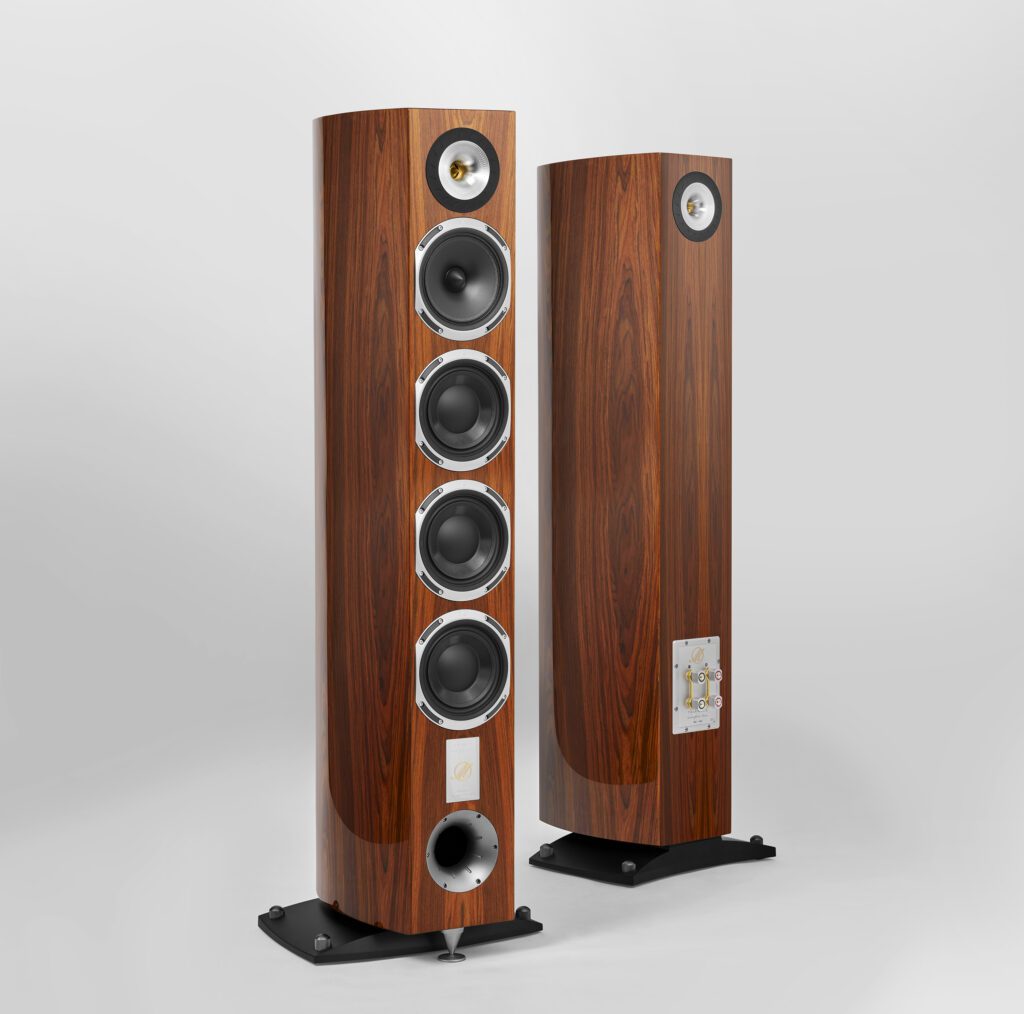
The further you listen into this recording, the more you hear past the voice, but in a way that’s Joni Mitchell. Moving across to a completely different recording – Carlos Kleiber’s masterful recording of Beethoven’s Fifth Symphony with the Vienna Philharmonic [DG] – you still get the intellectual lead of the music from the violins and can hear into the woodwind and brass effortlessly, but it’s overwatched by flutes and underpinned by percussion beautifully. That bass is lusty and dynamic (as said, it needs to be to keep pace with the midrange). Moving over to ZZ Top and then to Massive Attack and over to Trentemøller via the medium of Orbital (old and new) and the Triangle’s performance was extremely consistent; extremely fast, extremely open in the midrange and that openness extending up into the treble and down into the bass.
The rear-firing tweeter is more than just there for show, and it adds some expansiveness to the general sound. This comes into its own in the biggest rooms but doesn’t overpower those at the lower end of the room-size range. Returning to the Beethoven seems to give the strings a greater sense of scale and space.
Observations…
There’s not really a criticism here, but there is an observation. The Triangle sound is different and therefore not for everyone, and you discover that for yourself when you move back to the speakers you knew well after a long audition session. If you listen to your previous loudspeakers and think you hear a more balanced sound, the Quatour 40th Anniversary is probably not for you. On the other hand, if you listen to them and think your loudspeakers sound arch, false, slow and muddied – especially in the midrange – the Triangles just got under your skin. And at that point, you will probably not settle for anything else.
There are a few brands where you conclude that ‘either X is right or everyone else is’ and this is usually a veiled insult; it’s suggesting that the brand or designer has gone a bit off the rails and in making a distinctive sound, they are making something distinctively wrong. But not here; either Triangle is right with the Magellan Quatour 40th Anniversary about getting the midrange right, and getting it fast, or everyone else is and uniformity is there for a reason. I think it’s not about daring to be different… it’s about daring to be right.
Technical specifications
- Type Bass-reflex three way, six-driver floorstanding loudspeaker
- Drivers 2× TZ2900PMMG Magnesium dome tweeter (one front, one rear-firing), 1× T16GMF100 midrange driver, 3× T16GMMT15GS2 bass drivers
- Sensitivity 91dB/W/m
- Frequency response 33Hz–30kHz ±3dB
- Low-frequency roll-off 350Hz, 12dB/octave slope
- High-frequency roll-off 2.6kHz, 24dB/octave slope
- Nominal impedance 8Ω
- Minimum impedance 3Ω
- Finishes Space Black, Golden Oak, Shadow Zebrano
- Dimensions (W×H×D, with pedestal) 42 × 37 × 134cm
- Weight 46.9kg
- Price £14,000 per pair
Manufacturer
Triangle
UK distributor
SCV Distribution
+44(0)3301 222 500
Tags: FLOORSTANDING LOUDSPEAKERS TRIANGLE MAGELLAN QUATOUR 40TH ANNIVERSARY
By Alan Sircom
More articles from this authorRead Next From Review
See all
PrimaLuna EVO 100 phono preamplifier
- Apr 22, 2024

Reiki Audio SuperSwitch Master Pro + Servant Pro
- Mar 27, 2024

Melco Audio N1-S38 music server
- Mar 27, 2024








